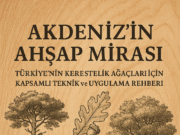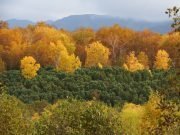Abies spp.(Fir)
Usually autumn planting does not require any processing. If spring planting will be done, it should be planted as early as possible in the spring after 3-4 weeks of cold folding in humid sand. (In February if possible) If A.cilicica is planted early, no further action is required.
Acer campastre (Lowland Maple)
It is planted in the spring after pretreatment in a hot environment for 4 weeks and a cold environment for 12-24 weeks.
Acer cappadocicum (Eastern Black Sea Maple)
It is planted in the spring after pre-treatment in a cold environment for 12-16 weeks.
Acer palmatum (Japanese Maple)
Fresh seeds are sown quickly in autumn after being collected. However, it should be protected against early frost in the spring or it is planted in the spring after being kept in a hot environment for 4 weeks and a cold environment for 4-12 weeks.
Acer platanoides (Sycamore Leaf Maple)
It is sown immediately after collection or stored in a dry and cool place until the end of February and sown in early spring after folding in damp sand for 12-16 weeks in a cold environment at 1-5 degrees.
Acer pseudoplatanus (Mountain Maple)
For a small amount of seeds, it is treated like A.platanoides. For large quantities, it is planted in the spring after being kept naked for 6-12 weeks in a cold environment.
acer rubrum
Although it is possible to store for a long time, it can be planted immediately after collection.
Acer saccharum (Sugar Maple)
It should be planted quickly after harvesting. Because it quickly loses its vitality.
Aesculus hippocastanum (Horse Chestnut)
It should be planted immediately after harvesting in the fall. Or it should be planted after being left in cold stratification until spring. Imported dried seeds should be swelled in warm water before planting.
Ailanthus altissima (Smelly Tree)
It should be planted at the end of winter or in the spring after being folded in damp sand in cold conditions for up to 8 weeks.
Albizzia julibrisima (Gülbrishim)
By treating with sulfuric acid, the germination barrier is removed.
Alnus spp. (Alder)
It should be planted in the spring by mixing with sand after 4 weeks of cold storage.Berberis (Women's Salt Shaker)
It is planted in spring after being folded in cold conditions between 6-13 weeks.
Betula (Birch)
Seeds should be sown in the spring, mixed with sand after cold storage, naked. It can be planted in the fall or even on snow.
Camellia (Tea Plant)
Seed pods should be planted before they set. If the bark is hardened, hot water is poured on it and it is planted after 24 hours in gradually cooling water.
Carpinus betulus (Common Hornbeam)
It is planted in spring after being kept in heat for 4 weeks and cold for 12-14 weeks.
Carya (Walnut)
Either the seed is planted in the fall without any treatment, or it is planted in the spring after being kept in a cold environment for 13 weeks.
Castanea sativa (Chestnut)
It should be planted in autumn (October-November) or sown in the spring by cold mulching in damp sand until spring.
Catalpa spp (Catalpa)
Seeds are sown in the spring by keeping them at room temperature during the winter months without the need for any pre-treatment.
Cedrus libani (Taurus Cedar)
It is sown in autumn or spring by cold mulching in 4 weeks of sand.
Celtis occidentalis (Western Strawberry)
It can be sown in the fall or sown in the spring after 8-12 weeks of cold stratification.
Cecis siliquastrum (Redbud)
In autumn, the seeds can be sown as soon as they are collected. If it is planted in spring, it is necessary to fold it in cold water about 2 months before.
Chaenomeles japonica (Japanese Quince)
Sow immediately in autumn after picking, or sow in spring after 2 weeks of hot treatment and 8-16 weeks of cold treatment.
Chamaecyparis spp. (Kamasiparis-Liar Cypress) (
It is planted after 8-12 weeks of cold folding in the sand.
Corylus avellana (Common Hazelnut)
Planted in autumn after cleaning and swelling in water for 2 days. If it is to be planted in spring, it is subjected to cold folding for 12-16 weeks.
Cotoneaster salicifolia (Mineum Medlar)
It is planted in spring after 12 weeks of hot and 12 weeks of cold stratification.
Crataegus monogyna and Crataegus oxycantha (Hawthorns)
It is planted in spring after 4-8 weeks of hot folding and 12-16 weeks of cold folding.
Source: Prof.Dr. Suad ÜRGENÇ- Nursery and Cultivation Technique
Eleagnus angustifolia
It is planted in autumn or sown in spring by applying 4 hours of hot and 8-12 hours of cold stratification after acid treatment.
Eucalyptus spp. (Eucalyptus)
Planted in the spring after being stored dry.
Fagus spp. (Beech)
It can be sown directly into the soil or after 1-20 weeks of cold mulching.
Fraxinus angustifolia (Spiked Fruit Ash)
It is planted in the spring after 2-4 weeks of cold stratification.
Fraxinus excelsior (Common Ash)
It is planted in spring after 8-12 hours of hot and 8-12 hours of cold layering.
Fraxinus ornus (Flower Ash)
It is planted in the fall or in the spring after 2-4 weeks of hot and 12 weeks of cold mulching.
Ginkgo bloba (Temple Tree)
It is planted in moist sand after 4-8 weeks of cold folding.
Ilex aquifolium (Holder)
Although the method to remove the germination barrier has not been found yet, 40 weeks of hot and 24 weeks of cold folding is recommended.
Juglans nigra (Black Walnut) and Juglans regia (Common Walnut)
The hard-shelled seed, which is obtained by removing the fruit shells, is planted in humid sand after 12-20 weeks of cold folding.
Juniperus spp (Junipers)
After the fleshy part of the cone is shredded or washed and the seeds are cleaned, it is planted in humid sand by cold folding for 4-20 weeks depending on the species.
Ligustrum spp. (Privet)
It is subjected to cold folding for 8-12 weeks.
Liquidambar orientlis (Anatolian Sweetgum Tree)
It is planted without any pre-treatment.
Source: Prof.Dr. Suad ÜRGENÇ- Nursery and Cultivation Technique
Magnolia spp. (magnolias)
Seeds should be sown immediately after they have been collected and cleaned in the fall. If the seeds dry out or are kept at room temperature for the winter, they lose their vitality. If it is to be planted later, it should be cold folded for 12-24 weeks. After sowing, the germination medium should never remain dry.
Mahonia aquifolium (Mahonya)
It can be planted after 5-13 weeks of cold stratification.
Morus alba (Akdut) and Morus nigra (Black Mulberry)
It is planted in the spring after being kept naked for 4-12 weeks in a cold environment.
Ostrya carpinifolia (Rock)
It is sown after 8 weeks of hot and 16-20 weeks of cold mulching.
Pittosporum spp. (Pitosporum)
The germination of the seed is not difficult. If the seeds placed in a bag are kept in boiling water for a few seconds, germination will accelerate.
Platanus spp. (sycamores)
The fruits collected from the tree at the end of winter are crushed and the seeds are separated, then mixed with sand and planted directly in the spring.
Prunus cerasifera (Ornamental Plum)
The fleshy part of the fruit is cleaned and washed and planted after 2 weeks of hot and 18 weeks of cold folding.
Quercus spp. (Oaks)
After the seed is collected, it should be sown immediately in the fall. Otherwise, it should be planted after 4-8 weeks of cold folding in damp sand until spring. There is no need for cold folding in Q.cerris, Q.petraea, Q.robur.
Robinia pseudoacacia (Red Acacia)
It is planted in late March or early April by folding in moist sand after applying one of the methods of acid, mechanical damage or swelling in hot water.
Rosa canina (Rosehip)
It is planted in spring after 8 weeks of hot and 8-12 weeks of cold folding.
Taxus baccata (Yew)
Seeds separated from the fleshy part are folded and planted in the spring of the next year. Seeds can be planted in batches, leaving 4 years in folding.
Tilia spp (Linden)
When the fruits turn from green to brown-yellow, they should be planted immediately. Otherwise, it should be planted after 4-20 weeks of heat and 20-24 weeks of cold folding.
Thuja occidentalis (Western Thuja)
It can be sown directly or if 8 weeks of folding is applied, better results are obtained.
Viburnum spp. (Snowball)
There is no effective method to remove the germination barrier. For this reason, the seeds should be removed before the fruits are fully matured and planted in the summer and the pillows should be kept moist.
Source Used: Prof. dr. Suad ÜRGENÇ- Nursery and Cultivation Technique






























